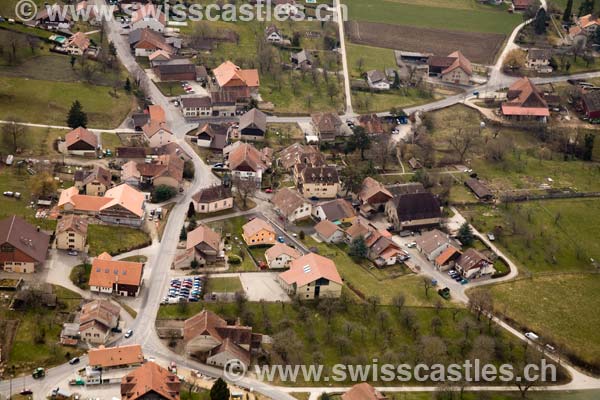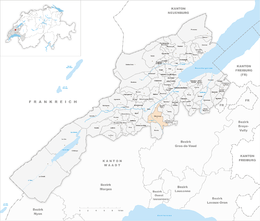Chavornay, Switzerland
Chavornay is a municipality in the district of Jura-Nord Vaudois in the canton of Vaud in Switzerland.
Geography
Chavornay is located on 452 m above sea level. M., 4 km south-east of Orbe and 10 km southwest of the district capital Yverdon- les- Bains ( straight line ). The village is located on the eastern edge of the Orbeebene, between the rivers of talent in the south and Ruisseau de Sadaz in the north, in the Vaud Mittelland.
The area of 11.1 km ² large municipality area includes a portion of the Vaud Mittelland. The western part of the territory is occupied by the wide plain of Orbe, of the channelized reaches of the Nozon ( formed in parts the western border ), the talent and the Entrerocheskanals drained. In the plane are the former clay pits the Brickyard, which partly renatured today are partly left to themselves, have filled over time with water and now form pond with significant bird populations. To the southeast of the municipality extends over the ground gently rising slope in the catchment area of the stream Ruisseau de Sadaz to the edge of the plateau of northern Gros de Vaud. In the Bois Désert is 608 m above sea level. M. reached the highest point of Chavornay. In the far south, the area extends into the deeply cut into the molasse of Gros de Vaud valley of talent. From the municipality surface 1997 14 % came from settlements, 16 % of forest and woody plants, 66 % in agriculture and somewhat less than 4% was unproductive land.
To Chavornay include extensive new housing developments, the farm estate Pâquier ( 439 m above sea level. M. ) in the midst of Orbeebene west of Entrerocheskanals as well as some individual farms. The neighboring communities of Chavornay are in the west and northwest Orbe, in the northeast Essert- Pittet, in the east-northeast Suchy, in the east Corcelles -sur- Chavornay, in the southeast Penthéréaz, to the south and southwest Bavois Arnex -sur -Orbe.
Population
With 3788 inhabitants ( 31 December 2012) Chavornay belongs to the medium-sized municipalities in the canton of Vaud. Of the 88.6% inhabitants are French-speaking, German-speaking 3.7 % and 2.2 % portugiesischsprachig (as of 2000). The population of Chavornay amounted in 1850 to 805 inhabitants, 1900 to 798 inhabitants. During the 20th century the population grew slowly but steadily. Increased growth is only in recent decades has been observed (1980 only 1598 inhabitants).
Economy
Chavornay was up to the beginning of the 20th century, mainly stamped by agriculture village. Even today, agriculture (especially vegetable crops ) and fruit growing have some significance in the occupational structure of the population. At the exposed south-facing slopes there are some small wine-growing regions.
On talent since the 16th century was a mill. With the improved transport links important companies took up residence since the end of the 19th century. Previously, the company was the most important brick Barraud, which until 1966 was from 1906 into operation. 1977 originated in Chavornay a large bonded warehouse. In addition, there are now many smaller and medium-sized enterprises, including in the fields of mechanical, body, electrical engineering, construction and horticulture.
In recent decades, the village has developed thanks to its attractive location and into a residential community. Many workers are therefore commuters who work in Orbe, in the space of Yverdon- les -Bains and Lausanne area.
Traffic
The community is a very good transport developed. It lies on the main route from Lausanne to Orbe. The motorway connection Chavornay at the 1981 opened A1 (Lausanne -Yverdon ) is just 1 km from the center. Bussigny -pres-Lausanne railway line Neuchâtel - - On May 7, 1855 Yverdon section was inaugurated with a train station in Lausanne Chavornay. The branch line from Chavornay to Orbe was taken on April 7, 1894 by the Chemin de fer Orbe Chavornay in operation. For the dispersion in public transport Postbus course, which runs from Chavornay to Echallens provides.
History
The municipality's territory remains of a settlement from the Roman period, as well as Roman coins and a milestone were discovered. The first documentary mention of the place was already in the year 927 as in villa Cauorniaco. Later, the names Cavorniacum ( 977 ) Cavornacum ( 1173 ) published for the first time Chavornay ( 1217 ), then Chauornai and Chavornai ( 1228 ), Chauornay ( 1453) and Chavornex ( 1628). The place name probably goes back to the Gallic family names Cavorinius.
Chavornay belonged since the 9th century, the Kingdom of Upper Burgundy, and was once the residence of the Kings. From her whereabouts but no remains are left. In the 11th century it came to the bishop of Lausanne; in the 13th century expanded Savoy also its influence on Chavornay. From the 11th to the late 15th century, a noble family of Chavornay is mentioned. The settlement possessed certain freedoms in the Middle Ages.
With the conquest of Vaud by Bern in 1536 Chavornay came under the administration of the bailiwick of Yverdon. It formed in a Kastlanei with its own Court. After the collapse of the ancien régime Chavornay belonged from 1798 to 1803 during the Helvetic Republic to the canton of Geneva, who came up then with the enactment of the Act of Mediation in the canton of Vaud. 1798 was assigned to the district of Orbe.
Attractions
The church, now reformed parish church of Saint -Marcel is mentioned in the 12th century. The present building dates from the Middle Ages ( around 1400) and has a late Gothic choir from the 15th century and a remarkable ship with wooden ceiling and pillars, which was rebuilt from 1648 to 1671.
On the main road stands the Bernese house ( Maison Bernoise ), which was built in the late 16th century. It got its name due to the architecture held in the Bernese style. In the old town there are many more stately town and farmhouses, partially also in the Bernese style, dating from the 17th and 18th centuries.










